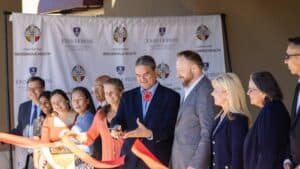Dramatic play reveals power of Indigenous stories and community
Center for Indigenous Research launches Great Plains Hub
The Johns Hopkins School of Medicine created a new research hub in South Dakota

Donald Warne, co-director for the Center for Indigenous Research, cuts the ribbon on the new Great Plains Hub at the Mandalay Plaza in Rapid City. (Photo by Amelia Schafer, ICT/Rapid City Journal)
The Johns Hopkins Center for Indigenous Health established its third hub, bringing groundbreaking Indigenous research to the Black Hills.
On Sept. 20, Indigenous leaders and local leaders gathered to welcome the new Great Plains Native Health Hub to Rapid City. The hub will lead research in Indigenous healthcare, intersecting cultural teachings and traditional medicine with modern medicine.
“Being located here in Rapid City is beautiful,” said Dr. Courtney Claussen, Mnicouju/Oohenumpa Lakota and a research associate. “There are tons of incredible team members located across the nation, so having the interconnections, not only from nation to nation but to the communities of South Dakota, we were able to meet with a lot of really great folks from the Great Plains region working in the health care area.”
Lakota and Dakota people in the Great Plains experience some of the lowest life expectancies in the United States. On the Crow Creek Reservation, the life expectancy rate is a stark 45 years compared to a statewide average of 76 years.
Indigenous people Nationwide experience higher rates of diabetes, heart disease and cancer.
“These relationships and these collaborations are going to change life as we know it for those of us that live on reservations,” said Crow Creek Sioux Tribe Chairman Peter Lengkeek. “This (center) lets me know that my grandchildren and their children are going to live longer than 45 years, they’re going to live a long healthy life.”
The center has various offices across the Navajo Nation and a Great Lakes Hub in Duluth, Minnesota.
Standing outside the Mandalay Plaza on Rapid City’s South Side, Center for Indigenous Health o-Director Donald Warne was presented with various different gifts for the new clinic. Researchers from the Great Lakes Hub and various clinics in the Navajo Nation brought pottery, beadwork and paintings to decorate the new center.
Local leaders such as Rapid City Mayor Jason Salumun and Monument Health CEO Paulette Davidson also joined the celebration to welcome the new research initiatives.
“Hearing the statistics about (Indigenous) life expectancy is sobering,” Salamun said. “I don’t want that for any people in Rapid City and I think having a goal to improve that through research development in healthcare is important because it’s about the next generation. We need people here to invest in the next generation.”
Aside from research, the center aims to engage in community-building, providing training for those interested in healthcare and eventually establishing an Indigenous School of Medicine.
“I went to medical school in the late 80s and early 90s, so a long time ago, but there was almost a sense of pride in the idea of education by humiliation, of breaking down the students to build them into a cookie cutter mold of what a doctor should be,” Warne, Oglala Lakota, said. “So the idea is we need a medical education system that’s focused on healing the healers so they can be more effective when working with our populations and incorporating Indigenous culture.”
There are a number of locations that the Center is considering for an institute, and one strong contender is Rapid City.
“Being located right here in Rapid City gives us the opportunity to do more community engagement that can’t be done in Baltimore,” Warne said. “It has to be here in the communities. I think Rapid City is a great centralized location to do this work.”
This story is co-published by the Rapid City Journal and ICT, a news partnership that covers Indigenous communities in the South Dakota area.
External
Attendees join in solidarity to build path toward healing
This article was produced for ProPublica’s Local Reporting Network in partnership with Honolulu Civil Beat
ProPublica
Inspired by her grandparents, Tonah Fishinghawk-Chavez proves that caring for the community is an action, not just a word
Police and family looking for Angel Mendez and Zayne LaFountain
We paused some services to investigate and restore systems and we’re grateful for your patience






